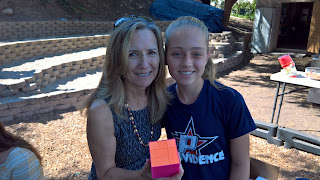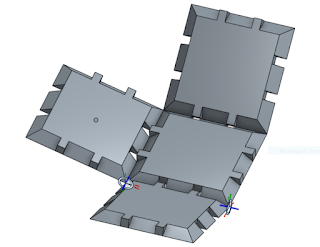The students have been hard at work learning the fundamentals of aerodynamics, as applied to conventional aircraft. They understand Bernoulli's principle, the momentum shift theory of lift, what induced drag is, and why most modern aircraft have those little turned-up ends on their wings. They know the value of the theoretical lift curve slope, and how much lift an uncambered airfoil produces at a zero angle of attack, and they can check it all in a virtual wind tunnel test! Impressed yet?!
 |
| Luke (11th) and Kylie (12th) consult their extensive course notes as they work on the detailed design spreadsheet |
Divided up into four teams, the students have just put the finishing touches on their complex design spreadsheet, which describes in precise detail the various features of the glider they are going to build. Each glider will be thrown from the top of the science lab building onto our field, carrying a single (unboiled!) egg to safety as far downfield as possible. The plane that successfully flies the farthest and lands safely wins!
 |
| Tys (12th), Victor (11th), Colby (11th), and Mikaela (12th) happily nearing the end of their design calculations after several weeks |
The students will be using a variety of materials and techniques; we are currently amassing a stockpile of carbon fiber tubes, balsa wood pieces, tissue paper, cellophane, lead weights, aluminum wire, and other bits and pieces. The teams are creating CAD models of their wing cross-sections, intending to 3D print them in the coming weeks. Most of the gliders are about three feet across the wingspan, about two feet long, and weigh a bit more than half a pound. (By the way, all of our work is done in metric units, to be in keeping with international physics standards!)
In order to get a real hands-on feel for the work, the group also took a special visit up to the Santa Ynez Airport, where they were shown a variety of gliders and powered aircraft. This was the perfect chance to connect theory to practice, and it no doubt helped inspire the students as they move into the manufacturing phase.
 |
Josh and Gabe look at the cockpit
of an older glider
|
Dave and Colby, employees of the airport, graciously showed us around the couple of dozen light aircraft sitting on the runway, answering student questions about wing design, gliding techniques, and the pilot license process.
 |
| Megan and Caleb dreaming big as they stand by another one of the gliders |
 |
The students look on as Colby describes the sleek and elegant
Cirrus light aircraft
|
As more airplanes took off and landed around them, the students got up close views of a shiny Cirrus, many older Cessnas, and an unusual-looking Long-EZ. Colby described to us the great thrill of flying, being in perfect solitude up in the sky; he is working towards his powered pilot license.
 |
| Is it a spaceship of some sort? The Long-EZ design is not recommended for the students to imitate for their glider design |
 |
| The class's six seniors from left to right: Tys, Mikaela, Caleb, Megan, Aaron, and Kylie; our guide Colby on the right |
With plenty to fill their heads about glide paths, turbulent flow, night navigation, wing construction, parachutes, and fuel pods, the students took one final pose on an aircraft they were allowed to sit in! Thanks very much to Dave and Colby and all of the crew up at Santa Ynez—perhaps we'll see you again sometime soon! Airport Day is coming up on Saturday, May 20th, and all are welcome.











